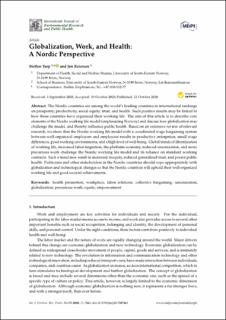| dc.contributor.author | Torp, Steffen | |
| dc.contributor.author | Reiersen, Jon | |
| dc.date.accessioned | 2021-03-12T09:31:35Z | |
| dc.date.available | 2021-03-12T09:31:35Z | |
| dc.date.created | 2020-10-29T15:33:24Z | |
| dc.date.issued | 2020 | |
| dc.identifier.citation | Torp, S., & Reiersen, J. (2020). Globalization, Work, and Health: A Nordic Perspective. International Journal of Environmental Research and Public Health (IJERPH), 17 (20). | en_US |
| dc.identifier.issn | 1661-7827 | |
| dc.identifier.uri | https://hdl.handle.net/11250/2733071 | |
| dc.description.abstract | The Nordic countries are among the world’s leading countries in international rankings on prosperity, productivity, social equity, trust, and health. Such positive results may be linked to how these countries have organized their working life. The aim of this article is to describe core elements of the Nordic working life model (emphasizing Norway) and discuss how globalization may challenge the model, and thereby influence public health. Based on an extensive review of relevant research, we show that the Nordic working life model with a coordinated wage bargaining system between well-organized employers and employees results in productive enterprises, small wage differences, good working environments, and a high level of well-being. Global trends of liberalization of working life, increased labor migration, the platform economy, reduced unionization, and more precarious work challenge the Nordic working life model and its reliance on standard working contracts. Such a trend may result in increased inequity, reduced generalized trust, and poorer public health. Politicians and other stakeholders in the Nordic countries should cope appropriately with globalization and technological changes so that the Nordic countries will uphold their well-organized working life and good societal achievements. | en_US |
| dc.language.iso | eng | en_US |
| dc.rights | Navngivelse 4.0 Internasjonal | * |
| dc.rights.uri | http://creativecommons.org/licenses/by/4.0/deed.no | * |
| dc.title | Globalization, Work, and Health: A Nordic Perspective | en_US |
| dc.type | Peer reviewed | en_US |
| dc.type | Journal article | en_US |
| dc.description.version | publishedVersion | en_US |
| dc.rights.holder | © 2020 by the authors. | en_US |
| dc.source.volume | 17 | en_US |
| dc.source.journal | International Journal of Environmental Research and Public Health (IJERPH) | en_US |
| dc.source.issue | 20 | en_US |
| dc.identifier.doi | https://doi.org/10.3390/ijerph17207661 | |
| dc.identifier.cristin | 1843336 | |
| dc.source.articlenumber | 7661 | en_US |
| cristin.ispublished | true | |
| cristin.fulltext | original | |
| cristin.qualitycode | 1 | |

